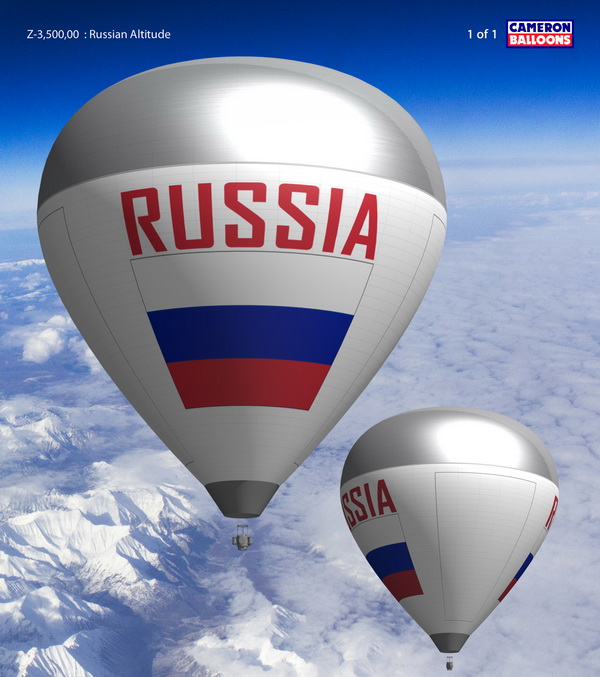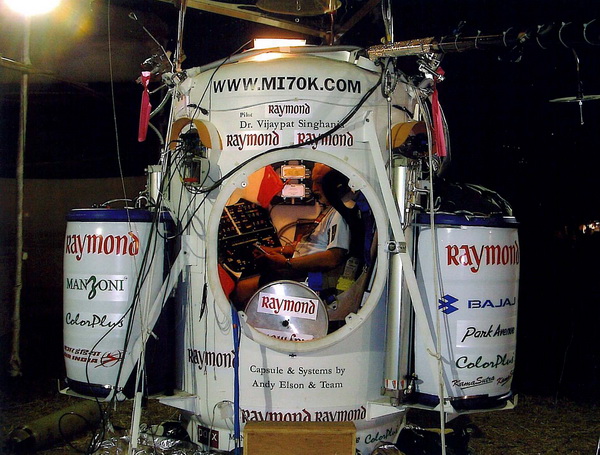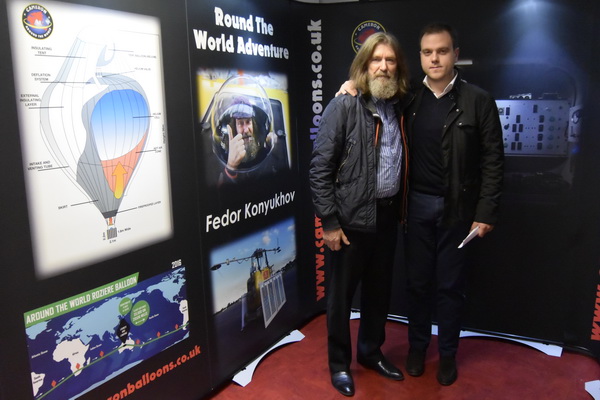Hot-Air Balloon High-Altitude Record Attempt
Fedor Konyukhov is to attempt another, balloon world-record… a hot-air adventure, high up in the Stratosphere and he has chosen Cameron Balloons as his balloon manufacturer once again.

After three successful, non-stop, round-the-world balloons built by Cameron Balloons; the first in 1999 sponsored by Breitling, the second in 2002 flown solo by Steve Fossett and most recently a 56metre tall balloon flown in 2016 by Fedor Konyukhov, whose solo, magnificent flight, around-the-world took just 11days, 8hours and 32minutes.
Cameron Balloons is now beginning the planning for a new world-record attempt with Adventurer, Fedor Konyukhov.

Cameron Balloons Z-3,500,000 Envelope
The Altitude Balloon – Fast Facts.
The balloon envelope will be the largest, hot-air balloon EVER built.
It will be a Cameron Balloons Z-3,500,000 hot-air envelope, with a volume of 3.5million cubic feet.
The envelope will stand over 68metres tall, will be over 61metres at its widest point and will need over 8,500 metres (8.5km) of fabric to build it.
The Aim of the Project.
Fedor’s aim is to fly higher than the current world-record held by Indian Businessman Vijaypat Singhania, who on in November 2005 flew to an astonishing altitude of 21,027m (68,986 ft) in a Cameron Balloons 1.6million cubic foot, Z-1600, hot-air balloon – over Mumbai, India VJ broke all previous world-records, landing successfully and safely, a few hours later.

It is Fedor’s wish (and something he is particularly looking forward to, as he has wanted to see this for himself since he was a young boy) to fly high enough to see the curvature of the earth and to look out at the inky-blackness of the cosmos – which can be observed from altitudes of about 35,000metres / 114,800feet.

Cameron Balloons High Altitude Gondola
Fedor Konyukhov is working towards a high-altitude, record-breaking, solo, hot-air balloon flight which he plans to launch from the ‘Cosmodrome’ in Siberia, Russia.
The high altitude balloon is to be built by Cameron Balloons in Bristol, the world’s experts in lighter-than-air flight.
To give you an idea of the scale of this project (and a quick guide through the layers of atmosphere into space).
Fedor will fly through the Troposphere and into the Stratosphere…
The Troposphere is the ‘layer’ nearest the ground and is 5 to 9 miles (8 to14 kilometres) thick – depending on where you are on Earth. (It is thinner at the North and South Pole.) This section of the earth’s atmosphere has the air we breathe and the majority of the ‘weather’ clouds and is made up of 78% nitrogen, 21% oxygen with the last 1% comprising of argon, water vapour and carbon dioxide. The air is densest in this lowest layer holding three-quarters of the mass of our entire atmosphere.
Above the Troposphere layer is the Stratosphere, the layer that Fedor intends to fly within. This layer of our atmosphere also has its own set of layers. There are no storms or turbulence here to mix up the air, so cold, heavy air sinks to the bottom and ‘warmer’, lighter air remains at the ‘top’. The total opposite of how the ‘layers’ work in the Troposphere. The Stratosphere ‘layer’ is about 22 miles or 35 kilometres thick and contains the important ozone layer. The ozone layer’s main ‘job’ is to absorb the majority of ultraviolet radiation from the sun.

Although some swans can fly at Fedor’s intended record-breaking altitude – generally most jet aircraft fly below, with most being operated at about 30,000ft (smaller fixed-wing aircraft usually only fly at up to, about 10,000ft, where most other birds fly)
Fedor intends to fly nearly four times higher than Mount Everest’s summit peak which stands at 8,848metres/29,028 feet (Everest’s summit is the world’s highest elevation above sea level).
Additionally, there is also a layer where Auroras happen, the Ionosphere, where gases, with charged ion particles that have been affected by the Earth and Sun’s magnetic fields can be clearly observed glowing and shimmering in ‘waves’ of light, most usually around the poles visible against the long dark winter skies.
The next layer, although also too high for our project, is known as Mesosphere and is about 22miles or 35kilometres thick and is the place where meteor showers or shooting stars burn-up across the sky as they whizz through this layer with the effect of friction of air, creating enormous heat and light that can be seen from the ground.
The Thermosphere layer lies in between the Mesosphere and the edge of space and temperatures in this layer can reach up to 4,500 degrees Fahrenheit / 2,482 degrees Celsius although if you could be in that environment you would be very cold because there aren’t enough gas molecules to transfer the heat to you. This also means there aren’t enough molecules for any sound to travel through either. This layer of Earth’s atmosphere is about 319 miles or 513 kilometres thick, much thicker than the inner layers of the atmosphere,
but not as thick as the exosphere. The thermosphere is also home to the International Space Station as it orbits Earth as well as other low Earth orbit satellites.
Lastly, there is the Exosphere, the very edge of our atmosphere, the next area would be outer space. This layer is about 6,200 miles or 10,000 kilometres) thick. That’s almost as wide as Earth itself. The Exosphere is enormous and contains some gases including hydrogen and helium, but the molecules are very spread out with a lot of empty space in between and it’s very cold.

Timescales for the project… well, so far, we have had a very productive initial meeting with the Konyukhov’s and Mikhail Simonyan – president of Open Sea Foundation and Fedor has indicated that he would like to attempt the high altitude hot-air balloon flight in late summer 2017 – but like all our other big projects, sponsors-wishes and funding-streams play an important part in final timescales – so we at Cameron Balloons have agreed to a nine-month timescale from the sales agreement order point to this enormous hot-air balloon being ready for delivery.
Cameron Balloons Ltd